- Home
- Experiences
- Museums on Capri
Museums on Capri
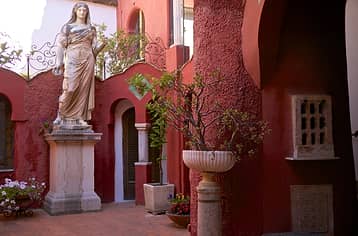
.jpg/w86_h80_ccenter.jpeg)



Capri is more than just beaches and boutiques. The island also has a wealth of history and culture that can be explored in the many small museums on the island. They are beautiful for the gorgeous venues, including small churches or noble residences once home to illustrious international artists and intellectuals, as well as the interesting collections they hold.
An itinerary including the museums on the Island of Capri should begin at Villa San Michele in Anacapri. Once you arrive in Piazza Vittoria, one of the stops on the bus route from Capri and Marina Grande, walk up the steps in the square and take Viale Axel Munthe to the left.
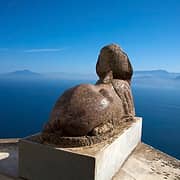
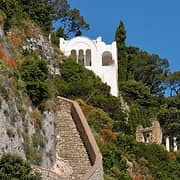
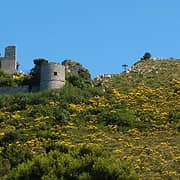
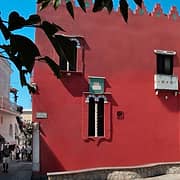
A walk along this scenic lane is a memorable experience in itself. Enjoy the colorful flowers, shade from the lush oleander hedges, the heady scent coming from the perfume and "limoncello" shops lining the road, and the jumble of artisan wares displayed in the workshops sitting shoulder to shoulder so closely that it resembles an Oriental bazaar.
This eye-catching meander ends at Villa San Michele, the historic residence of the Swedish physician Axel Munthe, an avid collector of antique finds from Roman and other archaeological sites. Here visitors can admire architectural decorations and frescoes from Roman, Egyptian, and Etruscan ruins and stroll through the lovely garden, with its sweeping view from the overlook guarded by an Egyptian sphynx.
From this idyllic spot, visitors can see the Castello Barbarossa, a 15th century fort which is now a research center for migratory birds overseen by the Fondazione Axel Munthe. Castello Barbarossa—named for the pirate Khai-ed-Din who set it aflame in 1535—is open to the public all year round. For more information regarding opening hours, ask at the information office in the Piazzetta in Capri or in Piazza Vittoria in Anacapri.
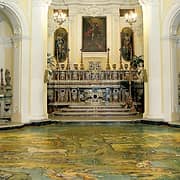
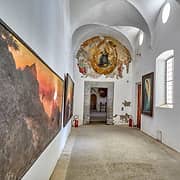
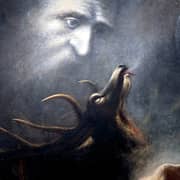
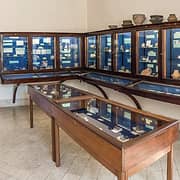
After leaving Villa San Michele, you can continue with one of the most recent museums on the island: Villa Rosa. It's a beautiful Art Nouveau residence that first belonged to English doctor Henry Thompson Green and then to Axel Munthe himself. Inaugurated as a museum in summer 2024, it now houses a permanent collection of the works of Capri painter Raffaele Castello as well as works by various artists and photographers who over the centuries have chosen the island of Capri as a refuge or place of inspiration.
Then take the tree-lined lane to the historic city gate of Anacapri, where the Phoenician steps lead down from Anacapri to Marina Grande.
If you've already visited the residence of Axel Munthe, head to Via Giuseppe Orlandi to stop in at the Casa Rossa, former residence of the American colonel John Clay H. Mackowen, another avid collector of archaeological finds unearthed on the island.
The building itself is a blend of a number of architectural styles and often hosts art exhibitions.
For those who appreciate sacred art, along Via Giuseppe Orlandi just before the church of Santa Sofia, the Church of San Michele is famous for its ornate handpainted majolica floor depicting Adam and Eve's Expulsion from the Garden of Eden.
The museum itinerary of the island of Capri is enriched by visiting the Charterhouse of St. Giacomo, where you can explore the museum dedicated to Karl Wilhelm Diefenbach, a picturesque late nineteenth-century German artist, lover of symbolism and precursor of the hippie movement. His works evoke an intense search for peace and harmony with nature, perfectly in line with the mystical atmosphere of the Charterhouse.
The Archaeological Museum of Capri, located in the Prior's Quarters of the Charterhouse of San Giacomo, offers a journey into the island's past. Inaugurated with the exhibition "The Island of the Caesars: Capri from Augustus to Tiberius", the museum hosts 120 artifacts, including marble sculptures, frescoes, and pottery. These artifacts, previously housed at the National Archaeological Museum of Naples, are now on display in Capri. The museum celebrates the island's historical connection with the sea and its central role during the Roman era.
Not far away, the Cerio Museum captures the historical and natural essence of Capri, thanks to the vast collection of artefacts and documents collected by Ignazio Cerio. This space celebrates the profound connection between the island and the Mediterranean through specimens of flora, fauna and important archaeological finds, making each visit a journey through time and Capri culture.
To return to Capri, take the bus at the stop right before the one in Piazza Vittoria toward "Il Cimitero", which is always much less crowded than the piazza stop... or hail a taxi.
History of the island
Things to do near Anacapri: